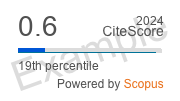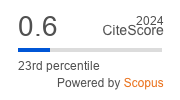Personalized algorithm for predicting the formation of bronchiectasis in patients with chronic mucopurulent bronchitis
https://doi.org/10.29001/2073-8552-2025-40-3-170-177
Abstract
Introduction. Chronic bronchitis is the most common chronic lung disease. The main problem of this disease is late diagnosis due to mild clinical symptomatology and untimely application of patients for medical help. One tool to solve this problem is the search of predictors of bronchiectasis development in patients with chronic mucopurulent bronchitis.
Aim: To optimize the prediction of bronchiectasis formation in patients with chronic mucopurulent bronchitis.
Material and Methods. Observation of 92 patients with chronic mucopurulent bronchitis was carried out and an attempt to predict bronchiectasis formation in them after 12 months of observation was made. The course of chronic mucopurulent bronchitis was assessed after 12 months. The main group was divided into two subgroups depending on the development of bronchiectasis according to chest computed tomography (CCT). The content of circulating annexin V mononuclear cells at different stages of apoptosis of circulating annexin V mononuclear cells and the neutrophil-lymphocyte index (NLI) were determined.
Results. To develop a personalized prediction of the probability of bronchiectasis formation in patients with chronic mucopurulent bronchitis after 12 months, the studied biomarkers were analyzed and the dynamics of these biomarkers were assessed after 12 months of observation (second control point). Increasing the probability of bronchiectasis development in patients with chronic mucous-purulent bronchitis according to the results of the study are: increase in the value of neutrophil-lymphocytic index at exacerbation of chronic mucous-purulent bronchitis by 1 increases the risk of bronchiectasis formation in 57,136. The presence of association of microbial agents increases the risk of bronchiectasis formation by 57,077 times. Increase in the specific weight (%) of circulating annexin V mononuclear cells at the early stage of apoptosis at the beginning of exacerbation by 1% increases the risk of bronchiectasis formation by 4,982 times, increase in disease duration by 1 year increases the risk by 1,633 times.
Conclusion. The obtained personalized algorithm for predicting the probability of bronchiectasis formation in patients with chronic mucopurulent bronchitis has high sensitivity and specificity – 96,6% and 98,4%, respectively.
About the Authors
A. V. VyazovoyRussian Federation
Artyom V. Vyazovoy - Clinical Resident, Department of Internal Medicine, Faculty of Pediatrics, Astrakhan State Medical University.
121, Bakinskaya str., Astrakhan, 414000
E. A. Polunina
Russian Federation
Ekaterina A. Polunina - Dr. Sci. (Med.), Associate Professor of Internal Medicine, Department of Internal Medicine, Pediatric Faculty, Astrakhan State Medical University.
121, Bakinskaya str., Astrakhan, 414000
T. V. Prokofieva
Russian Federation
Tatiana V. Prokofieva - Dr. Sci. (Med.), Associate Professor of Internal Medicine, Department of Internal Medicine, Pediatric Faculty, Astrakhan State Medical University.
121, Bakinskaya str., Astrakhan, 414000
O. S. Polunina
Russian Federation
Olga S. Polunina - Dr. Sci. (Med.), Head of Internal Medicine Department of Pediatric Department, Astrakhan State Medical University.
121, Bakinskaya str., Astrakhan, 414000
References
1. Kuraeva V.M., Feiginova S.I., Podchernina A.M. Analysis of morbidity indicators for the class of respiratory diseases in the adult population of Moscow and the Russian Federation. Metropolitan health. (in Russ.). 2022;3(1):6–14. URL: https://www.city-healthcare.com/jour/article/view/3 (12.09.2025).
2. Salagai O.O., Antonov N.S., Sakharova G.M., Stadnik N.M. Influence of tobacco use on individual and population risk of development of noninfectious diseases in the Russian Federation. Public Health. (in Russ.). 2024;4(2):18–31. https://doi.org/10.21045/2782-1676-20244-2-18-31.
3. Kodirov D., Akhmedov A.K. Chronic nonspecific inflammation of the lungs in persons of young age. Economy and society. (in Russ.). 2023;104(1):305–308. URL: https://www.iupr.ru/_files/ugd/b06fdc_4971e0d01af54309a638a88ccfd44725.pdf?index=true. (12.09.2025).
4. Prokofieva T.V., Polunina O.S., Sevostyanova I.V., Polunina E.A. Specific weight of circulating mononuclear cells in early apoptosis in patients with myocardial infarction against the background of chronic obstructive pulmonary disease. Modern problems of science and education. (in Russ.). 2023;3. https://doi.org/10.17513/spno.32578.
5. Yasseen B.A., Elkhodiry А.А., El-sayed H., Zidan M., Kamel A.G., Hamdy R. et al. Evidence associating neutrophilia, lung damage, hyperlactatemia, blood acidosis, impaired oxygen transport, and mortality in critically ill COVID-19 patients. BioRxiv. 2023;18(1):1–37. https://doi.org/10.1101/2023.09.17.558185.
6. Alnima T., Mulder M.M.G., van Bussel B.C.T. et al. COVID-19 coagulopathy: from pathogenesis to treatment. Acta Haematologica. 2022;145(3):282–296. https://doi.org/10.1159/000522498.
7. Davitt E., Davitt С., Mazer M.B., Areti S.S., Hotchkiss R.S., Remy K.E. COVID-19 disease and immune dysregulation. Best Practice & Research Clinical Haematology. 2022;35(3). https://doi.org/10.1016/j.beha.2022.101401.
8. Oflaz F.E., Bondarenko A.I., Trenker M., Waldeck-Weiermair M., Gottschalk B., Bernhart E. et al. Annexin A5 controls VDAC1-dependent mitochondrial Ca2+ homeostasis and determines cellular susceptibility to apoptosis. EMBO J. 2025;44(12):3413–3447. https://doi.org/10.1038/s44318-025-00454-9.
9. Lai X., Wang J., Duan J., Gong Y., Cao J. Apoptosis inhibitor of macrophage differentiates bacteria from influenza or COVID-19 in hospitalized adults with community-acquired pneumonia. Journal of Infection. 2021;84(4):579–613. https://doi.org/10.1016/j.jinf.2021.12.027.
10. Possebon L., Costa S., Souza H.R., Azevedo L.R., Sant'Ana M., Iyomasa-Pilon M.M. et al. Mimetic peptide AC2-26 of annexin A1 as a potential therapeutic agent to treat COPD. Int. Immunopharmacol. 2018;63(2):270–281. https://doi.org/10.1016/j.intimp.2018.08.011.
11. Borst O., Geue S., Manke M.C., Peng B., Münzer P., Kollotzek F. et al. Annexin A7 is a critical regulator of Ca2+ mobilization and lipid metabolism during platelet activation and arterial thrombosis. Eur. Heart J. 2020;41(2):3774. https://doi.org/10.1093/ehjci/ehaa946.3774.
12. Pryshliak O.Y., Marynchak O.V., Kondryn O.Y., Hryzhak I.H., Henyk N.I., Makarchuk O.M. et al. Clinical and laboratory characteristics of COVID-19 in pregnant women. J. Med. Life. 2023;16(5):766–772. https://doi.org/10.25122/jml-2023-0044.
13. Karimi A., Shobeiri P., Kulasinghe A., Rezaei N. Novel systemic inflammation markers to predict COVID-19 prognosis. Front. Immunol. 2021;12:741061. https://doi.org/10.3389/fimmu.2021.741061.
14. Cakirca G. Inflammation-based indices predicting mortality in COVID-19. Journal of the College of Physicians and Surgeons Pakistan. 2023;33(1):112–114. https://doi.org/10.29271/jcpsp.2023.01.112
Review
For citations:
Vyazovoy A.V., Polunina E.A., Prokofieva T.V., Polunina O.S. Personalized algorithm for predicting the formation of bronchiectasis in patients with chronic mucopurulent bronchitis. Siberian Journal of Clinical and Experimental Medicine. 2025;40(3):170-177. (In Russ.) https://doi.org/10.29001/2073-8552-2025-40-3-170-177





.png)





























